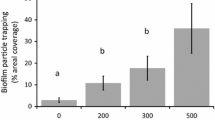Abstract
Laboratory experiments on resuspension of benthic diatoms were performed in 1988 on intact cores of sediment obtained from two transects in the Ems estuary (Dutch Wadden Sea, NW Europe). Diatoms were most abundant in sediment from sheltered stations. In the experiments, which were performed in a small carousel system, the percentage of resuspended diatoms increased concomitantly with angular velocity of the agitating paddles. Maximum microphytobenthos resuspension in terms of cell numbers was up to 45% of the total population present in the 0.5-cm top layer, and up to 11% in terms of chlorophylla. Maximum sediment resuspension was 6%. The results show that the presence of a diatom film (numerous cells on the sediment surface) increases sediment stability, thereby suppressing resuspension of sediment and diatoms. However, if the sediment contains many fine particles and much detritus, sediment stability decreases, leading to increased resuspension.
These results support the contention that low detritus content and large numbers stabilize the surface layer of tidal flats, whereas high detritus content and fewer cells (<2 × 105 cm−2) do not. The stabilization is thought to be dependent on a combination of differences in sediment consolidation and in bottom roughness caused by the presence or absence of diatom films.
Similar content being viewed by others
Literature cited
Admiraal, W. (1984). The ecology of estuarine sediment-inhabiting diatoms. In: Round, F. E., Chapman, D. J. (eds.) Progress in phycological research, Vol. 3. Biopress Ltd., Bristol, p. 232–269
Admiraal, W., Peletier, H. (1980). Influence of seasonal variations of temperature and light on the growth rate of cultures and natural populations of intertidal diatoms. Mar. Ecol. Prog. Ser. 2: 35–43
Admiraal, W., van Arkel, M. A., Baretta, J. W., Colijn, F., Ebenköh, W., Jonge, V. N. de, Kop, A., Ruardij, P., Schröder, H. G. J. (1988). The construction of the benthic submodel. In: Baretta, J., Ruardy, P. (eds.) Tidal flat estuaries, simulation and analysis of the Ems estuary. Ecological studies no. 71. Springer-Verlag, Berlin, p. 105–152
Baillie, P. W., Welsh, B. L. (1980). The effect of tidal resuspension on the distribution of intertidal epipelic algae in an estuary. Estuar. cstl Shelf Sci. 10: 165–180
Cadée, G. C. Hegeman, J. (1974). Primary production of phytoplankton in the Dutch Wadden Sea. Neth. J. Sea Res. 8: 240–259
Cadée, G. C., Hegeman, J. (1977). Distribution of primary production of the benthic microflora and accumulation of organic matter on a tidal area, Balgzand, Dutch Wadden Sea. Neth. J. Sea Res. 11: 24–41
Colijn, F., Dijkema, K. S. (1981). Species composition of benthic diatoms and distribution of chlorophylla on an intertidal flat in the Dutch Wadden Sea. Mar. Ecol. Prog. Ser. 4: 9–21
Colijn, F., Jonge, V. N. de (1984). Primary production of microphytobenthos in the Ems-Dollard estuary. Mar. Ecol. Prog. Ser. 14: 185–196
Colijn, F., Nienhuis, H. (1978). The intertidal microphytobenthos of the ‘Hohe Weg’ shallows in the German Wadden Sea. Forschungsstelle Norderney, Jahresbericht 1977. 24: 149–174
Demers, S., Therriault, J. C., Bourquet, E., Bah, A. (1987). Resuspension in the shallow sublittoral zone of a macrotidal estuarine environment: wind influence. Limnol. Oceanogr. 32: 327–339
Drum, R. W., Hopkins, J. T. (1966). Diatom locomotion: an explanation. Protoplasma 62: 1–33
Gordon, C. M. (1974). Intermittant momentum transport in a geophysical boundary layer. Nature, Lond. 248: 392–394
Grant, J., Bathmann, U. V., Mills, E. L. (1986). The interaction between benthic diatom films and sediment transport. Estuar. cstl Shelf Sci. 13: 225–238
Grøntved, J. (1949). Investigations on the phytoplankton in the Danish Waddensea in July 1941. Middelelser fra kommissionen for Danmarks fiskeri — og havundersøgelser 5: 1–55
Heathershaw, A. D. (1974). “Bursting” phenomena in the sea. Nature, Lond. 248: 394–395
Heckman, Ch. W. (1985). The development of vertical migration patterns in the sediments of estuaries as a strategy for algae to resist drift with tidal currents. Int. Revue ges. Hydrobiol. 70: 151–164
Jonge, V. N. de (1985). The occurrence of “epipsammic” diatom populations: a result of interaction between physical sorting of sediment and certain properties of diatom species. Estuar. cstl Shelf Sci. 21: 607–622
Jonge, V. N. de, Bergs, J. van den (1987). Experiments on the resuspension of estuarine sediments containing benthic diatoms. Estuar. cstl Shelf Sci. 24: 725–740
Kullenberg, G. (1971). Vertical diffusion in shallow waters. Tellus 23: 129–135
Kullenberg, G. (1972). Apparent horizontal diffusion in stratified vertical shear flow. Tellus 24: 17–28
Kullenberg, G. (1976). On vertical mixing and the energy transfer from the wind to the water. Tellus 28: 159–165
Levasseur, M., Therriault, J. C., Legendre, L. (1983). Tidal currents, wind and the morphology of phytoplankton spatial structures. J. mar. Res. 42: 655–672
Lorenzen, C. J. (1967). Determination of chlorophyll and phaeopigments: spectrophotometric equations. Limnol. Oceanogr. 12: 343–346
Niveaux, J., Panouse, M. (1987). Spectrofluorometric determination of chlorophylls and phaeophytins. Arch. Hydrobiol. 109(4): 567–581
Paterson, D. M. (1989). Short-term changes in the erodibility of intertidal cohesive sediments related to the migratory behavior of epipelic diatoms. Limnol. Oceanogr. 34: 223–234
Postma, H. (1967). Sediment transport and sedimentation in the estuarine environment. In: Lauff, G. H. (ed.) Estuaries. American Association for the Advancement of Science, Washington, p. 158–179
Therriault, J. C., Lawrence, D. J., Platt, T. (1978). Spatial variability of phytoplankton turnover in relation to physical processes in a coastal environment. Limnol. Oceanogr. 23: 909–911
Vos, P. C., Boer, P. L. de, Misdorp, R. (1988). Sediment stabilization by benthic diatoms in intertidal sandy shoals; qualitative and quantitative observations. In: de Boer, P. L., et al. (eds.) Tide influenced sedimentary environments and facies. Reidel, Dordrecht, p. 511–526
Author information
Authors and Affiliations
Additional information
Communicated by O. Kinne, Oldendorf/Luhe
Rights and permissions
About this article
Cite this article
Delgado, M., de Jonge, V.N. & Peletier, H. Experiments on resuspension of natural microphytobenthos populations. Mar. Biol. 108, 321–328 (1991). https://doi.org/10.1007/BF01344347
Accepted:
Issue Date:
DOI: https://doi.org/10.1007/BF01344347




